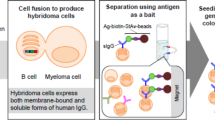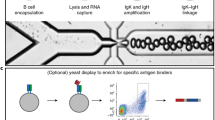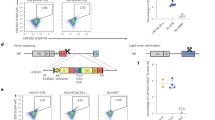Abstract
Monoclonal antibodies have proved extremely useful for the unambiguous identification, quantification and large-scale purification of a given antigen or a specific epitope. As they are highly specific for a given antigenic determinant, these antibodies are superior to conventional polyclonal antibodies. Since the discovery1 that mouse spleen B lymphocytes can be fused with mouse B-myeloma cells to yield hybrid cells (hybridomas) secreting specific antibodies derived from the spleen cell fusion partner, several modifications of this method have been used to improve the yield of surviving antibody-secreting hybridomas. We have now included, 5 days after the fusion proceedure, an additional step which stabilizes the hybrids against gene loss and improves growth conditions. We report here that, using this method, we have established several stable mouse hybridoma lines secreting monoclonal antibodies to human γ-interferon (HuIFN-γ).
This is a preview of subscription content, access via your institution
Access options
Subscribe to this journal
Receive 51 print issues and online access
$199.00 per year
only $3.90 per issue
Buy this article
- Purchase on SpringerLink
- Instant access to full article PDF
Prices may be subject to local taxes which are calculated during checkout
Similar content being viewed by others
References
Köhler, G. & Milstein, C. Nature 256, 495–497 (1975); Eur. J. Immun. 6, 511–519 (1976).
De Ley, M. et al. Eur. J. Immun. 10, 877–883 (1980).
Hochkeppel, H. K., Menge, U. & Collins, J. Eur. J. Biochem. 118, 437–442 (1981).
Staehelin, Th. et al. Proc. natn. Acad. Sci. U.S.A. 78, 1848–1852 (1981).
Laemmli, U. K. Nature 227, 680–685 (1970).
Towbin, H., Staehelin, T. & Gordon, J. Proc. natn. Acad. Sci. U.S.A. 76, 4350–4354 (1979).
Hunter, W. M. & Greenwood, I. C. Nature 194, 495–496 (1962).
Author information
Authors and Affiliations
Rights and permissions
About this article
Cite this article
Hochkeppel, H., de Ley, M. Monoclonal antibody against human IFN-γ. Nature 296, 258–259 (1982). https://doi.org/10.1038/296258a0
Received:
Accepted:
Issue date:
DOI: https://doi.org/10.1038/296258a0



